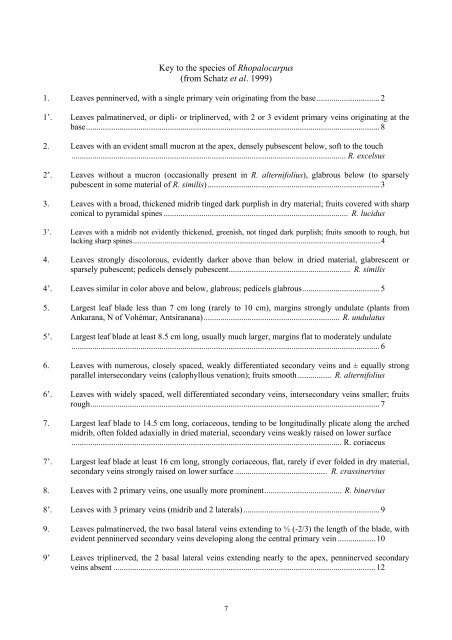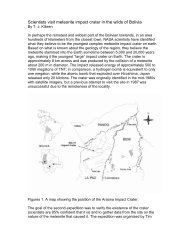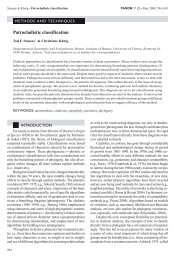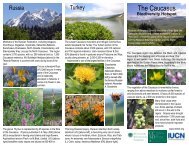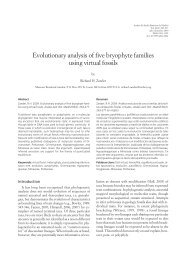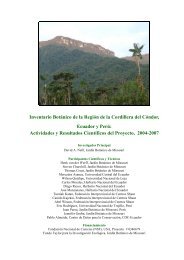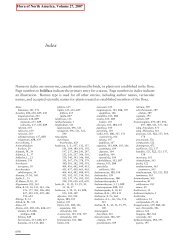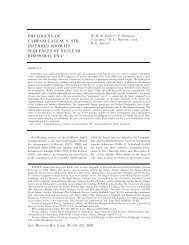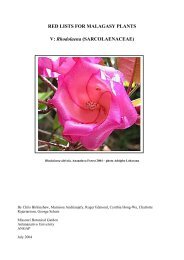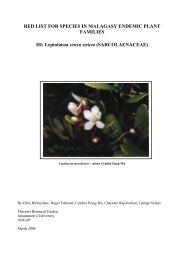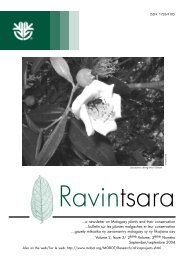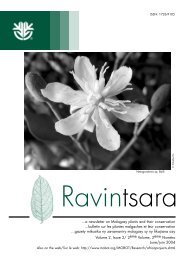red lists for malagasy plants iv: sphaerosepalaceae - Missouri ...
red lists for malagasy plants iv: sphaerosepalaceae - Missouri ...
red lists for malagasy plants iv: sphaerosepalaceae - Missouri ...
Create successful ePaper yourself
Turn your PDF publications into a flip-book with our unique Google optimized e-Paper software.
Key to the species of Rhopalocarpus<br />
(from Schatz et al. 1999)<br />
1. Leaves penninerved, with a single primary vein originating from the base.............................. 2<br />
1’. Leaves palmatinerved, or dipli- or triplinerved, with 2 or 3 evident primary veins originating at the<br />
base............................................................................................................................................ 8<br />
2. Leaves with an evident small mucron at the apex, densely pubsescent below, soft to the touch<br />
................................................................................................................................... R. excelsus<br />
2’. Leaves without a mucron (occasionally present in R. alternifolius), glabrous below (to sparsely<br />
pubescent in some material of R. similis).................................................................................. 3<br />
3. Leaves with a broad, thickened midrib tinged dark purplish in dry material; fruits cove<strong>red</strong> with sharp<br />
conical to pyramidal spines ........................................................................................ R. lucidus<br />
3’. Leaves with a midrib not evidently thickened, greenish, not tinged dark purplish; fruits smooth to rough, but<br />
lacking sharp spines..................................................................................................................................4<br />
4. Leaves strongly discolorous, evidently darker above than below in dried material, glabrescent or<br />
sparsely pubescent; pedicels densely pubescent.......................................................... R. similis<br />
4’. Leaves similar in color above and below, glabrous; pedicels glabrous..................................... 5<br />
5. Largest leaf blade less than 7 cm long (rarely to 10 cm), margins strongly undulate (<strong>plants</strong> from<br />
Ankarana, N of Vohémar, Antsiranana)................................................................. R. undulatus<br />
5’. Largest leaf blade at least 8.5 cm long, usually much larger, margins flat to moderately undulate<br />
................................................................................................................................................... 6<br />
6. Leaves with numerous, closely spaced, weakly differentiated secondary veins and ± equally strong<br />
parallel intersecondary veins (calophyllous venation); fruits smooth ................ R. alternifolius<br />
6’. Leaves with widely spaced, well differentiated secondary veins, intersecondary veins smaller; fruits<br />
rough.......................................................................................................................................... 7<br />
7. Largest leaf blade to 14.5 cm long, coriaceous, tending to be longitudinally plicate along the arched<br />
midrib, often folded adaxially in dried material, secondary veins weakly raised on lower surface<br />
................................................................................................................................. R. coriaceus<br />
7’. Largest leaf blade at least 16 cm long, strongly coriaceous, flat, rarely if ever folded in dry material,<br />
secondary veins strongly raised on lower surface ............................................ R. crassinervius<br />
8. Leaves with 2 primary veins, one usually more prominent..................................... R. binervius<br />
8’. Leaves with 3 primary veins (midrib and 2 laterals)................................................................. 9<br />
9. Leaves palmatinerved, the two basal lateral veins extending to ½ (-2/3) the length of the blade, with<br />
evident penninerved secondary veins developing along the central primary vein .................. 10<br />
9’ Leaves triplinerved, the 2 basal lateral veins extending nearly to the apex, penninerved secondary<br />
veins absent ............................................................................................................................. 12<br />
7


